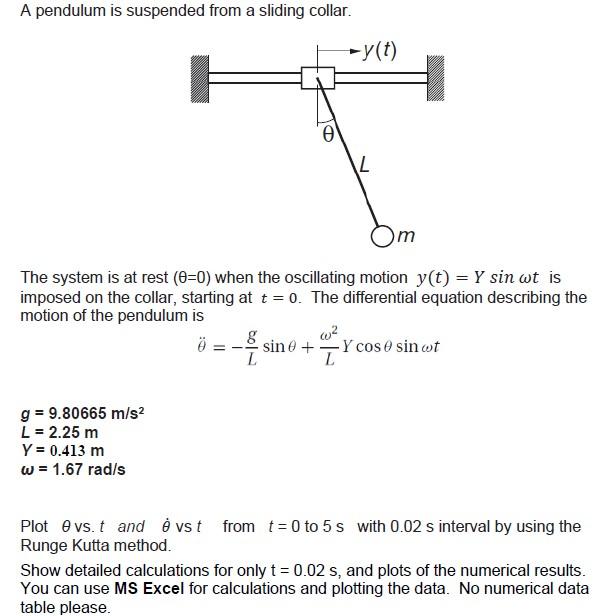Home /
Expert Answers /
Statistics and Probability /
numerical-methods-a-pendulum-is-suspended-from-a-sliding-collar-the-system-is-at-rest-theta-0-pa455
(Solved): numerical methods A pendulum is suspended from a sliding collar. The system is at rest \( (\theta=0 ...

A pendulum is suspended from a sliding collar. The system is at rest \( (\theta=0) \) when the oscillating motion \( y(t)=Y \sin \omega t \) is imposed on the collar, starting at \( t=0 \). The differential equation describing the motion of the pendulum is \[ \ddot{\theta}=-\frac{g}{L} \sin \theta+\frac{\omega^{2}}{L} Y \cos \theta \sin \omega t \] \[ \begin{array}{l} g=9.80665 \mathrm{~m} / \mathrm{s}^{2} \\ L=2.25 \mathrm{~m} \\ Y=0.413 \mathrm{~m} \\ \omega=1.67 \mathrm{rad} / \mathrm{s} \end{array} \] Plot \( \theta \) vs. \( t \) and \( \dot{\theta} \) vs \( t \) from \( t=0 \) to \( 5 \mathrm{~s} \) with \( 0.02 \mathrm{~s} \) interval by using the Runge Kutta method. Show detailed calculations for only \( \mathrm{t}=0.02 \mathrm{~s} \), and plots of the numerical results. You can use MS Excel for calculations and plotting the data. No numerical data table please.
Expert Answer
Answer:- Runge kutta method: Since, we know that Runge kutta method is for 1storder diff equation but we have given 2ndorder differential equation, so